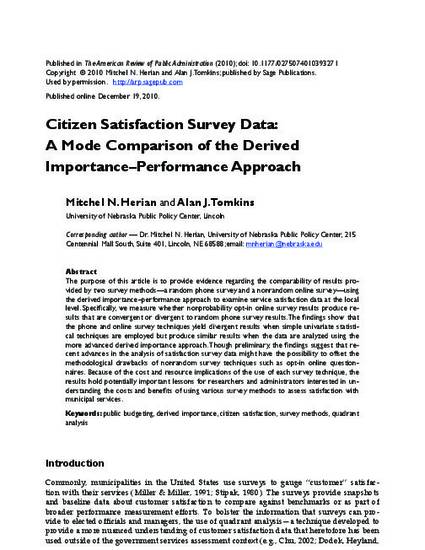
Other
Citizen Satisfaction Survey Data: A Mode Comparison of the Derived Importance–Performance Approach
Publications of Affiliated Faculty: Nebraska Public Policy Center
Date of this Version
12-1-2010
Disciplines
Abstract
The purpose of this article is to provide evidence regarding the comparability of results provided by two survey methods—a random phone survey and a nonrandom online survey—using the derived importance–performance approach to examine service satisfaction data at the local level. Specifically, we measure whether nonprobability opt-in online survey results produce results that are convergent or divergent to random phone survey results. The findings show that the phone and online survey techniques yield divergent results when simple univariate statistical techniques are employed but produce similar results when the data are analyzed using the more advanced derived importance approach. Though preliminary, the findings suggest that recent advances in the analysis of satisfaction survey data might have the possibility to offset the methodological drawbacks of nonrandom survey techniques such as opt-in online questionnaires. Because of the cost and resource implications of the use of each survey technique, the results hold potentially important lessons for researchers and administrators interested in understanding the costs and benefits of using various survey methods to assess satisfaction with municipal services.
Citation Information
Mitchel Norman Herian and Alan J. Tomkins. "Citizen Satisfaction Survey Data: A Mode Comparison of the Derived Importance–Performance Approach" (2010) Available at: http://works.bepress.com/alan_tomkins/35/

Published in The American Review of Public Administration (2010); doi: 10.1177/0275074010393271 Copyright © 2010 Mitchel N. Herian and Alan J. Tomkins; published by Sage Publications. Used by permission. http://arp.sagepub.com Published online December 19, 2010.